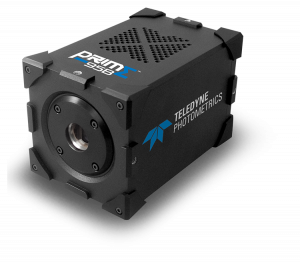Dr. Paul Maddox, Assistant Professor,
The University of North Carolina at Chapel Hill, Biology Department
Background
Conventional light sheet fluorescence microscopy (LSFM) is performed with two objectives oriented orthogonally to each other so that one objective introduces the light sheet and the other detects the fluorescence signal. However, this orientation requires the detection objective to be placed slightly away from the sample to prevent the two objectives colliding in space. Therefore, a long working distance detection objective is necessary which means that high NA, oil-immersion objectives are incompatible with the conventional LSFM design.
This presents a problem for the detection of cellular or subcellular structures which require a high NA detection objective and coverslip-based mounted samples for the superior resolution and light collection efficiency.
The Mizar TILT overcomes this problem by removing the illumination objective and introducing a tilted light sheet through a photomask and cylindrical lens which can be made to converge at the working distance of high NA objectives. In this way, high magnification and high NA (60x, 1.49), oil-immersion objectives can be used to image coverslip-based mounted samples.

Image acquired on the Mizar TILT under 150x magnification with a 1.49NA TIRF objective, 0.2 µm step size. 100 ms exposure using the Prime 95B scientific CMOS camera, cropped to 550×750 pixels.
Sample kindly provided by Dr. Dan Mulvihill, University of Kent https://www.kent.ac.uk/bio/profiles/staff/mulvihill.html
Challenge
Like all light sheet systems, the Mizar TILT is designed to minimize photodamage and photobleaching to live samples by reducing the light source intensity and reducing exposure times. This allows for longer acquisitions to be made to monitor live processes over longer timescales.
One way to reduce exposure times is to use a more sensitive camera. CMOS devices are typically used in LSFM for the combination of a large field of view and fast speed but the sensitivity isn’t that high. EMCCD cameras are more sensitive than CMOS devices but suffer from small fields of view and slow speeds which makes them unappealing for LSFM applications.
The Prime 95B Scientific CMOS [sCMOS] camera is, right now, the best solution we have found for TILT imaging. Coupling the Prime 95B to the TILT generates an extremely powerful imaging system!
Solution
The back-illuminated Prime 95B Scientific CMOS camera with an almost perfect 95% quantum efficiency and large 11µm pixels is the perfect fit for the Mizar TILT.
The sensitivity of the Prime 95B is equivalent to an EMCCD but it retains the field of view and speed advantages of a CMOS camera. Furthermore, the larger pixels of the Prime 95B allow for high-resolution imaging with higher magnification objectives which the Mizar TILT was designed to use. This allows exposure times to be reduced and cells to be imaged for much longer with high detail.
Dr. Paul Maddox, assistant professor at the University of North Carolina at Chapel Hill is the creator of the Mizar TILT and founder of Mizar Imaging, shares with us, “The Prime 95B Scientific CMOS camera is, right now, the best solution we have found for TILT imaging. The outstanding quantum efficiency and pixel size allow imaging of a wide diversity of samples of varying brightness whilst enabling Nyquist sampling in space and time for even the most challenging samples. Coupling the Prime 95B to the TILT generates an extremely powerful imaging system!”

